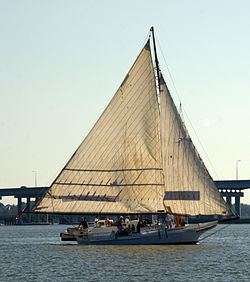Architect Unknown NRHP Reference # 85001089 Year built 1905 | Architectural style Other Designated NHL April 19, 1994 Added to NRHP 16 May 1985 | |
 | ||
MPS Chesapeake Bay Skipjack Fleet TR | ||
Hilda M. Willing is a Chesapeake Bay skipjack. Built in 1905 at Oriole, Maryland she is a relatively small skipjack whose home port is Chance, Maryland .
Contents
She was declared a National Historic Landmark in 1994.
The Willing is one of two skipjacks listed as National Historic Landmarks. The Willing was listed along with the Kathryn as one of the few skipjacks built prior to 1943 that remained in good condition. Willing was particularly noteworthy as an example of a small skipjack with good sailing qualities.
History
The Hilda M. Willing was built in 1905 at Oriole, Maryland on the Manokin River off Tangier Sound, in Somerset County, Maryland. Her home port was Crisfield, Maryland. In 1926 her owner was Samuel L. Laird of Oriole. Laird sold her to Thornton Webster of Wenona in 1927, who sold her on to Roland Bozman of Wenona in 1929. Bozman sold the Willing to R.E. Hoffman, and she was resold to Addie M. Jones by 1941. She was owned by T. Rayner Graham in 1943, who abandoned her in Annapolis. She was purchased for $400 by Leslie Pope of Oxford, Maryland who moved her to Cambridge, Maryland, then sold her to Robert F. "Pete" Sweitzer in 1947 for $1600. Sweitzer owned the Willing into the 1990s and did much of the repair and maintenance work on her himself.
Sweitzer altered the Willing to suit technological advances. He was the first to use an automobile engine instead of the then-common one-cylinder Hettinger engines to operate the dredge gear. The installation of this engine meant that the skipjack's freeboard could be raised 8 inches (20 cm) for better stability, as the power assist made the low freeboard of pre-1930 skipjacks less necessary. Sweitzer lengthened the boomdeepened the centerboard and added a small skeg to the keel. He also took the traditional extreme rake out of the mast, making it vertical.
In November 2011, Hilda M. Willing was brought home to the Eastern Shore of Maryland and is currently an active dredgeboat under Capt. David Whitelock - www.skipjackpreservation.org.
Willing's sailing qualities are among the best in the skipjack fleet. It is stated that she is the only skipjack that can come about without the use of the centerboad, and that she can dredge in strong winds without a jib.
Description
The Willing is 40 feet (12 m) long, 14 feet (4.3 m) wide and draws 3.08 feet (0.94 m). She has a traditional clipper bow-shaped cutwater in a sharp, but convex bow, and a square transom. She carries a pushblock for a pushboat to allow her to dredge in light airs. The kinbg plank runs from the bow past the mast, but stops short of the main hatch. Following a second, smaller hatch, a small doghouse is set on the deck to provide low headroom in what would otherwise be a very low cabin, 2.5 feet (0.76 m) high. A box at the stern contains the hydraulic steering gear installed by Sweitzer to replace the original patent gear. Davits for the pushboat hang over the transom.
The Willing is rigged with a jib-headed mainsail, or leg-of-mutton, with a single large jib. She carries dredges on each side with a shared motor.
